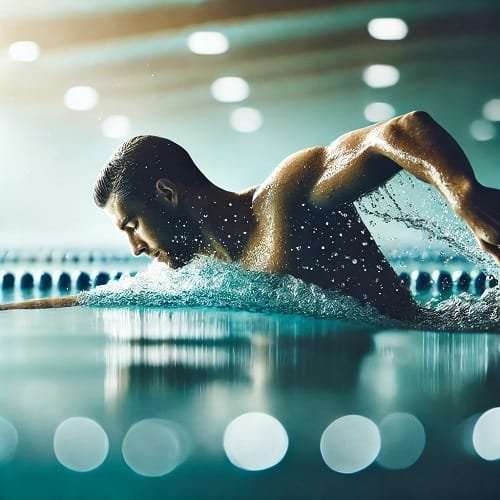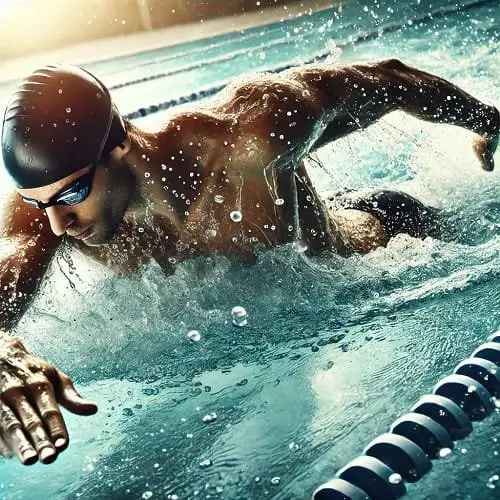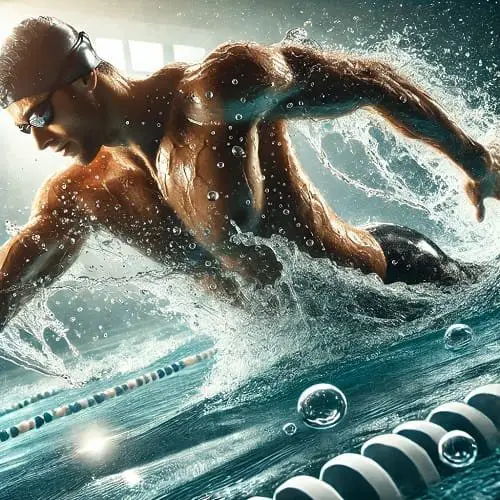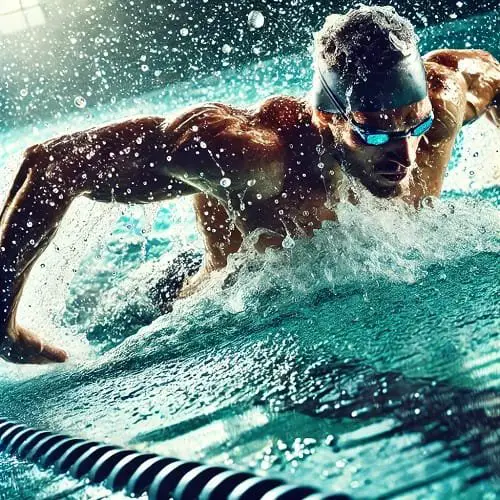1. Introduction
Looking for a workout that maximizes fat burning, builds muscle, and transforms your fitness in a fraction of the time? HIIT swimming workout is the ultimate solution. Combining the intensity of high-intensity interval training (HIIT) with the resistance of swimming, this workout offers an exciting and effective way to reach your fitness goals. Whether you’re looking to enhance endurance, burn calories, or improve overall strength, the HIIT swimming workout delivers powerful results.
At its core, HIIT swimming involves short bursts of intense swimming followed by brief recovery periods. This combination keeps your body challenged and your metabolism elevated, allowing you to burn fat and build lean muscle while enhancing cardiovascular health. It’s no wonder HIIT swimming has become so popular as a fitness method in recent years.
In this blog, you’ll learn about the numerous benefits of HIIT swimming, from weight loss to muscle toning, all while engaging in a fun, full-body workout. As you read further, you’ll see how this dynamic exercise routine can support your fitness transformation, helping you achieve impressive results faster than traditional workouts. Ready to dive into a workout that can truly boost your fitness? Let’s explore the world of HIIT swimming workouts and uncover how they can help you reach your full potential.
Table of Contents
2. What is HIIT Swimming?

HIIT swimming workout is a dynamic and powerful approach to fitness that blends the benefits of high-intensity interval training (HIIT) with the invigorating nature of swimming. Unlike traditional swimming, which often involves steady, moderate-paced laps, HIIT swimming incorporates swimming intervals of intense effort followed by brief recovery periods. This structure is designed to challenge your body in a way that maximizes fat burning, builds endurance, and increases muscle strength.
The key difference between traditional swimming and HIIT swimming lies in the intensity and the training method. In traditional swimming, you might swim for extended periods at a steady pace, focusing on building aerobic capacity. However, HIIT swimming pushes you to alternate between intense, all-out efforts and short rest periods, making it a combination of aerobic and anaerobic exercise. This contrast allows you to get the benefits of both endurance and strength training in a shorter amount of time.
A significant advantage of the HIIT swimming workout is that it provides a full-body workout. Each burst of speed activates multiple muscle groups simultaneously, engaging your arms, legs, core, and even your back. As a result, HIIT swimming helps tone and strengthen muscles throughout your entire body while also improving cardiovascular health.
Moreover, HIIT swimming offers a mix of aerobic and anaerobic benefits. The aerobic aspect improves stamina and cardiovascular fitness, while the anaerobic component focuses on building muscle strength and power. This combination makes HIIT swimming an incredibly efficient workout that targets multiple fitness goals, including fat loss, muscle building, and improved overall performance. The swimming benefits are vast, from burning more calories to enhancing flexibility, all while providing a fun and challenging experience.
3. Why Choose HIIT Swimming for Your Fitness Goals?

If you’re looking to accelerate your fitness journey and achieve outstanding results, HIIT swimming workout is the ultimate choice. It stands out as a versatile and effective method for tackling multiple fitness goals, including fat loss, muscle building, and endurance. Whether you’re just starting out or an experienced athlete, this workout can be tailored to fit your fitness level and provide consistent progress.
One of the biggest reasons why HIIT swimming is so effective is its ability to torch calories and burn fat quickly. The combination of high-intensity intervals and short rest periods revs up your metabolism, promoting calorie burning even after your workout is over. This post-workout calorie burn, known as excess post-exercise oxygen consumption (EPOC), is one of the reasons HIIT swimming helps achieve faster fat loss than traditional steady-state cardio workouts. It’s an ideal choice for those seeking to shed unwanted weight and improve body composition.
In addition to fat loss, HIIT swimming workout offers incredible cardiovascular benefits. The high-intensity bursts followed by recovery periods engage your heart and lungs in a way that improves overall cardiovascular health. This makes HIIT swimming an excellent workout for boosting endurance and stamina. As you continue to challenge yourself, your body adapts and becomes more efficient at using oxygen, allowing you to swim faster and longer.
Another remarkable advantage of HIIT swimming is its ability to aid in muscle building. Unlike many forms of cardio, which often lack the resistance needed for muscle growth, HIIT swimming incorporates bodyweight resistance as you move through the water. Each stroke and kick works to strengthen and tone muscles throughout your body, particularly in the legs, arms, and core. This makes it an effective strength training method that enhances both muscle definition and power.
With its impressive calorie burning potential and its ability to improve endurance and muscle building, HIIT swimming is truly a workout for everyone. No matter your fitness level, you can modify the intensity to meet your needs, making it a powerful tool to achieve your fitness goals and enhance your overall well-being.
4. Benefits of HIIT Swimming for Your Body

When it comes to achieving a well-rounded and efficient workout, HIIT swimming workout offers a host of benefits that positively impact every area of your body. Not only does it provide an intense cardiovascular workout, but it also promotes fat burning, builds lean muscle, and enhances overall strength. Let’s explore how HIIT swimming can deliver impressive results for your body.
One of the primary benefits of HIIT swimming is its ability to accelerate fat burning. The high-intensity intervals push your body into fat-burning mode, helping to break down stored fat for energy. This is further amplified by the metabolism boost that occurs post-workout. As you alternate between bursts of intense swimming and recovery periods, your metabolism remains elevated for hours, allowing you to burn more calories even when you’re not swimming. Over time, this leads to a reduction in body fat and the development of lean muscle mass, creating a more toned, defined physique.
In addition to fat burning, HIIT swimming provides significant benefits for cardiovascular health. The short bursts of exertion followed by rest periods engage your heart and circulatory system, enhancing heart function and improving circulation. By consistently performing HIIT swimming workouts, you strengthen your cardiovascular system, which can lead to lower blood pressure, improved circulation, and a reduced risk of heart disease. These benefits extend beyond the workout, positively influencing your overall health and energy levels.
Another incredible benefit of HIIT swimming is its positive impact on core strength and posture. The resistance of water provides an excellent medium for building strength, particularly in your core muscles. Each stroke, whether it’s the freestyle, breaststroke, or backstroke, engages the abdominal muscles, helping to strengthen your core and improve posture. This added core strength translates into better balance and stability, which is beneficial not only for swimming but also for other sports and daily activities.
Moreover, HIIT swimming can greatly speed up recovery between workouts. The alternating high-intensity effort and rest periods allow your muscles to recover quickly while maintaining a high level of intensity throughout the session. This means you can work out more frequently without overtaxing your body. The combination of water resistance and active recovery in between intervals also aids in muscle relaxation, reducing soreness and promoting faster recovery.
From fat burning to core strength and improved cardiovascular health, the benefits of HIIT swimming workout are vast. With every swim, you’re not only improving your physical fitness but also enhancing your overall health and well-being.
ALSO READ
Chest HIIT Workout: 20 Minutes to a Stronger Chest
Top 7 Front Shoulder Workouts to Build Strength and Muscle
Ultimate Wrestling Workouts to Build Strength and Power
5. How to Do an Effective HIIT Swimming Workout

To maximize the benefits of HIIT swimming, it’s essential to structure your workout routine effectively. Here’s a step-by-step guide to doing an effective HIIT swimming workout that incorporates everything from warm-up to cool-down, with attention to technique and proper timing. Whether you’re a beginner or an advanced swimmer, following this structure will ensure you get the most out of every session.
I. Warm-Up (5–10 Minutes)
Before diving into your HIIT swimming workout, it’s important to start with a proper warm-up. Warming up helps increase your heart rate, loosens your muscles, and prepares your body for high-intensity exercise, reducing the risk of injury. Begin with some light lap swimming, focusing on smooth, controlled strokes. Swim at a comfortable pace, and perform gentle movements for both your upper and lower body. A good warm-up could include freestyle, backstroke, and breaststroke for a full-body engagement.
Additionally, try some dynamic stretches to further prepare your muscles, such as arm circles, leg swings, and trunk twists. This ensures your body is ready for the intense intervals to come.
II. Swimming Intervals: The Heart of the Workout (20–30 Minutes)
The core of a HIIT swimming workout lies in the swimming intervals. This involves alternating between intense bursts of effort and short periods of rest. Depending on your fitness level, the structure of these intervals may vary. Below is an example structure for a moderate HIIT swimming workout:
- Sprint Interval: Swim as fast as you can for 30 seconds to 1 minute. Aim for maximum effort, focusing on explosive speed. This could be a freestyle sprint or another stroke depending on your preference.
- Rest Period: After each sprint, rest for 20-30 seconds to allow your heart rate to recover slightly. This rest period can be spent floating, lightly kicking, or doing an easy stroke.
- Repeat the sprints and rest periods for a total of 8–12 intervals. As you progress in your fitness, you can increase the sprint duration or reduce the rest period.
Advanced Variation: For advanced swimmers, you can incorporate longer sprints, such as 1.5–2 minutes, and rest only 15–20 seconds between intervals. This will push your cardiovascular capacity and strength, further increasing your endurance.
III. Technique Focus During Intervals
Maintaining good technique during your HIIT swimming workout is crucial. Although the goal is to push yourself to your limits, sacrificing form can lead to poor results or even injury. Here are a few tips to ensure good form:
- Keep your body streamlined to reduce drag in the water.
- Focus on long, controlled strokes rather than short, choppy ones to maximize speed and efficiency.
- Ensure your breathing is steady, even during the most intense sprints. Exhale fully underwater to prepare for the next breath.
- Engage your core throughout each interval to maintain proper body position and reduce fatigue.
IV. Cool-Down (5–10 Minutes)
After completing the intense intervals, it’s essential to cool down properly. The cool-down phase helps gradually bring your heart rate back to its normal levels and aids in muscle recovery. Swim at a slower pace, focusing on easy, controlled strokes. You can also incorporate some light stretches, paying attention to your shoulders, legs, and back, which are heavily used during HIIT swimming.
V. Frequency and Variations for Different Fitness Levels
- Beginner: If you’re just starting out, aim to incorporate HIIT swimming into your routine twice a week. Begin with shorter intervals (e.g., 20 seconds of sprinting, 40 seconds of rest) and work your way up as you improve. Ensure that you have at least one rest day between workouts for muscle recovery.
- Intermediate: Once you’re comfortable, increase the intensity by lengthening the sprint intervals to 30 seconds to 1 minute, and reduce the rest period. You can also incorporate more strokes, like breaststroke and backstroke, to challenge different muscle groups.
- Advanced: For advanced swimmers, aim for 3-4 sessions a week. Increase sprint durations to 2 minutes, and incorporate varied strokes. You can also add dryland exercises like core work or resistance training to complement your HIIT swimming.
Practical Tips for Success
- Stay Consistent: To see improvements in fat loss, muscle building, and endurance, consistency is key. Aim to incorporate HIIT swimming into your routine 2–3 times per week.
- Listen to Your Body: Push yourself, but not to the point of exhaustion. Allow for proper recovery to prevent burnout and injuries.
- Track Progress: Keep track of your swim times and interval performance to monitor improvements. This will help keep you motivated and focused on your goals.
By following these steps, you’ll not only maximize the effectiveness of your HIIT swimming workout, but you’ll also enjoy a versatile, full-body workout that boosts endurance, burns fat, and builds strength.
6. Common Mistakes to Avoid in HIIT Swimming Workouts

When engaging in HIIT swimming workouts, it’s easy to get carried away by the intensity and excitement. However, making certain mistakes can hinder your progress or even lead to injuries. Here, we’ll explore the most common mistakes to avoid, along with tips on how to correct them, ensuring that you get the best results from your HIIT swimming sessions.
I. Improper Form
One of the biggest mistakes in HIIT swimming is sacrificing proper form in an attempt to swim faster or harder. Poor form not only reduces swimming efficiency but also increases the risk of injury. For example, excessive splashing, improper arm technique, or arching your back too much can create unnecessary strain on your body, ultimately leading to decreased performance and potential long-term damage.
Solution: Focus on maintaining a streamlined body position throughout the workout. Keep your core engaged and your strokes long and controlled. Pay extra attention to your technique, particularly when you start feeling fatigued, as it’s easy to slip into bad habits under stress. Regularly check your form during intervals to ensure maximum efficiency.
II. Overtraining and Burnout
It’s tempting to push your limits in HIIT swimming—after all, it’s all about intensity. However, overtraining can lead to burnout, diminished results, and an increased risk of injury. Swimming too many intervals without proper rest can wear you down, compromising both your performance and recovery.
Solution: Ensure you take sufficient rest periods between your intervals. Rest is just as important as the workout itself, allowing your body to recover and avoid exhaustion. If you’re new to HIIT swimming, begin with 2-3 sessions per week, gradually increasing the frequency as your body adapts. Listen to your body and allow it time to rest and repair between intense workouts.
III. Neglecting Injury Prevention
High-intensity workouts put significant stress on your muscles and joints, especially if you’re swimming with improper technique or overexerting yourself. Neglecting injury prevention can lead to problems such as shoulder strain or lower back pain, both of which can derail your fitness progress.
Solution: Dedicate time to warming up before starting, and never skip the cool-down phase. Incorporating stretching and mobility exercises into your routine will help keep your muscles flexible and reduce the likelihood of injuries. Also, make sure you’re using proper technique, especially during the intense intervals, and don’t hesitate to stop if you experience any pain or discomfort. Your body’s signals are crucial for injury prevention and long-term fitness success.
By avoiding these common mistakes and focusing on proper technique, adequate rest, and injury prevention, you can maximize the benefits of HIIT swimming workouts. This will help ensure that you stay safe, improve your performance, and continue progressing toward your fitness goals in a sustainable and efficient manner.
7. How Often Should You Do HIIT Swimming?

When it comes to HIIT swimming, finding the right balance between intensity and recovery is crucial for maximizing results. The frequency of your workouts depends largely on your fitness level, goals, and how your body responds to high-intensity training.
Frequency for Different Fitness Levels
For beginners, it’s recommended to start with 2-3 sessions per week. This allows your body to adapt to the demands of HIIT swimming while preventing overtraining. As you progress and your endurance improves, you can gradually increase the frequency to 4-5 sessions a week. Advanced swimmers may opt for daily sessions, but this should only be done with adequate recovery time between each workout to prevent burnout and injury.
Importance of Recovery Time
Recovery time plays a vital role in improving your fitness progress. After an intense HIIT swimming session, your muscles need time to repair and rebuild, which helps you increase strength and endurance over time. Without proper rest, your performance may plateau, and the risk of overtraining or injury rises. Be sure to include rest days in your workout schedule to give your body the time it needs to recover.
Structuring Your Workout Schedule
A well-structured weekly workout schedule for HIIT swimming might look like this:
- Beginners: 2-3 sessions per week, with at least 48 hours of rest between each session.
- Intermediate: 3-4 sessions per week, with 1-2 rest days.
- Advanced: 4-5 sessions per week, with 1-2 rest days for muscle recovery.
By carefully balancing frequency and recovery, you’ll ensure that your HIIT swimming workouts lead to continuous fitness progress without risking burnout.
8. Frequently Asked Questions (FAQ)
What are the main benefits of HIIT swimming?
HIIT swimming offers a full-body workout that combines fat burning, muscle building, and endurance training. The high-intensity intervals increase calorie burn while improving cardiovascular health and building lean muscle. It also boosts metabolism and enhances flexibility and core strength.
How fast can I expect to see results from HIIT swimming?
Results from HIIT swimming vary depending on your fitness level, consistency, and diet. However, many people begin to see improvements in stamina, strength, and fat loss within 3 to 6 weeks of consistent training. For visible results like muscle toning and fat reduction, expect about 4-8 weeks with regular workouts.
Can beginners try HIIT swimming workouts?
Absolutely! Beginners can start with lower-intensity HIIT swimming workouts, focusing on technique and gradually increasing the intensity. It’s essential to give yourself time to adapt and build endurance. As your fitness level improves, you can increase the intensity of the intervals.
Can I do HIIT swimming every day?
While HIIT swimming is a highly effective workout, it’s important to allow your body adequate recovery time between sessions. For most people, 3-4 times per week is ideal. Swimming every day without proper rest could lead to overtraining and increase the risk of injury. It’s essential to listen to your body and ensure you’re giving your muscles enough time to recover and rebuild for optimal performance.
Is HIIT swimming better than regular swimming for fitness?
HIIT swimming is more intense and effective than regular swimming for fat burning and muscle building. While traditional swimming provides great cardiovascular benefits and low-impact exercise, HIIT swimming amplifies the intensity by incorporating short bursts of high-speed effort followed by rest, boosting calorie burn and improving both aerobic and anaerobic fitness. It helps improve strength, stamina, and endurance more efficiently than traditional swimming, especially for those looking to speed up their fitness progress.
9. Conclusion
In conclusion, HIIT swimming offers a powerful and efficient way to transform your fitness. Whether you’re looking to lose fat, build muscle, or improve endurance, HIIT swimming results speak for themselves. With consistent effort and a solid routine, you’ll see noticeable changes in no time. Start today, embrace the challenge, and take the first step toward your fitness transformation!






